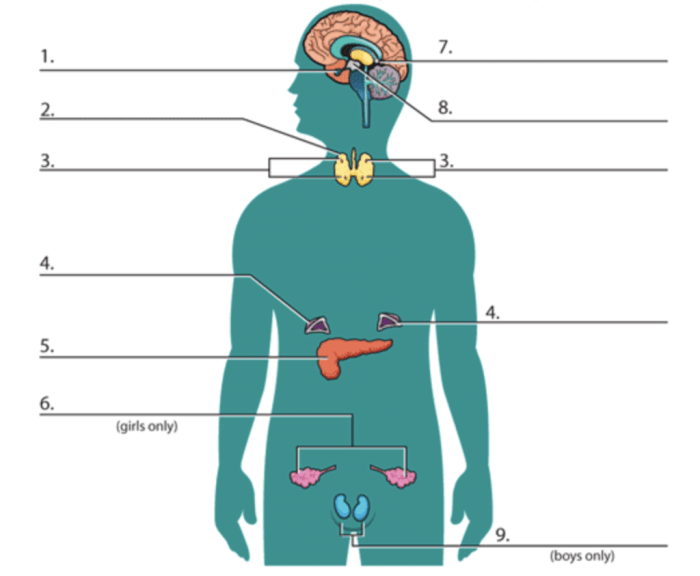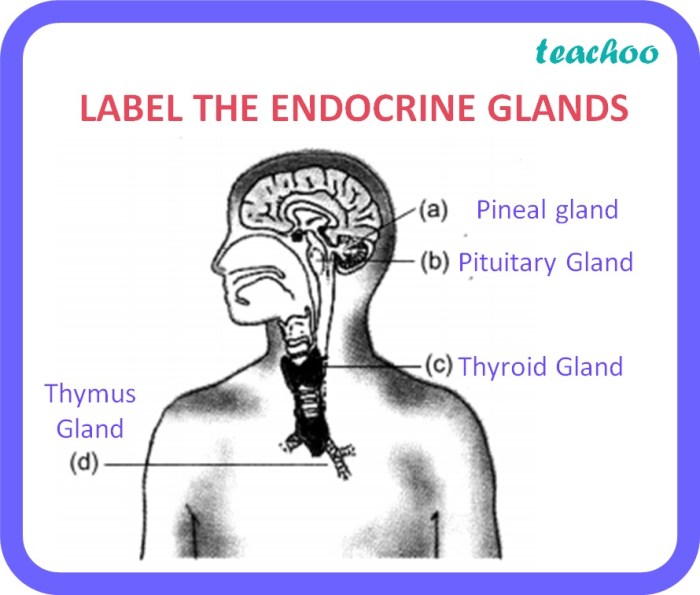Label the endocrine glands on the figure – Embarking on an exploration of the endocrine glands, this comprehensive guide unravels the intricacies of these vital structures, providing a foundation for understanding their pivotal role in maintaining human health. Delving into their location, structure, and functions, we illuminate the significance of accurately labeling endocrine glands on a figure, facilitating a deeper comprehension of human anatomy and physiology.
As we delve into the specifics of each endocrine gland, we uncover their unique contributions to the endocrine system, orchestrating a harmonious symphony of hormone production that regulates a vast array of bodily functions. From the pituitary gland, the master conductor, to the adrenal glands, responsible for our fight-or-flight response, each gland plays a distinct and essential role in maintaining homeostasis.
Introduction

Endocrine glands are specialized organs that secrete hormones directly into the bloodstream. Hormones are chemical messengers that travel throughout the body, regulating various physiological processes. Labeling endocrine glands on a figure serves as a valuable tool for visualizing their location and understanding their functions within the human body.
Endocrine Gland Types
- Pituitary gland:Located at the base of the brain, it produces hormones that regulate growth, metabolism, and reproduction.
- Thyroid gland:Found in the neck, it secretes hormones that control metabolism and energy levels.
- Parathyroid glands:Situated near the thyroid gland, they produce hormones that regulate calcium levels.
- Adrenal glands:Located above the kidneys, they secrete hormones involved in stress response, metabolism, and electrolyte balance.
- Pancreas:Located behind the stomach, it produces hormones that regulate blood sugar levels and digestion.
- Ovaries (females):Located in the pelvis, they produce hormones that regulate the menstrual cycle and reproductive functions.
- Testes (males):Found in the scrotum, they secrete hormones that regulate male reproductive functions and secondary sexual characteristics.
Endocrine System Function

The endocrine glands work together to maintain homeostasis, the body’s internal balance. Hormones secreted by these glands regulate a wide range of functions, including metabolism, growth, reproduction, stress response, and electrolyte balance. Dysregulation of hormone production can lead to various health issues.
Clinical Significance

Understanding the location and function of endocrine glands is crucial for diagnosing and treating endocrine disorders. Abnormal hormone production can cause conditions such as diabetes, thyroid disorders, and growth hormone deficiencies. Accurate labeling of endocrine glands on a figure facilitates effective communication between healthcare professionals and patients.
Educational Applications
Labeling endocrine glands on a figure enhances understanding of human anatomy. It allows students to visualize the location and interconnections of these glands, aiding in the comprehension of their physiological roles. By incorporating visual aids into teaching, educators can improve student engagement and retention of knowledge.
FAQ Explained: Label The Endocrine Glands On The Figure
What is the purpose of labeling endocrine glands on a figure?
Labeling endocrine glands on a figure provides a visual representation of their location and structure, facilitating a deeper understanding of their anatomy and function within the endocrine system.
How many major endocrine glands are there in the human body?
There are approximately 10 major endocrine glands in the human body, including the pituitary gland, thyroid gland, parathyroid glands, adrenal glands, pancreas, ovaries (in females), and testes (in males).
What is the role of hormones in the endocrine system?
Hormones act as chemical messengers, traveling through the bloodstream to target specific cells and tissues. They regulate a wide range of bodily functions, including metabolism, growth, reproduction, and mood.